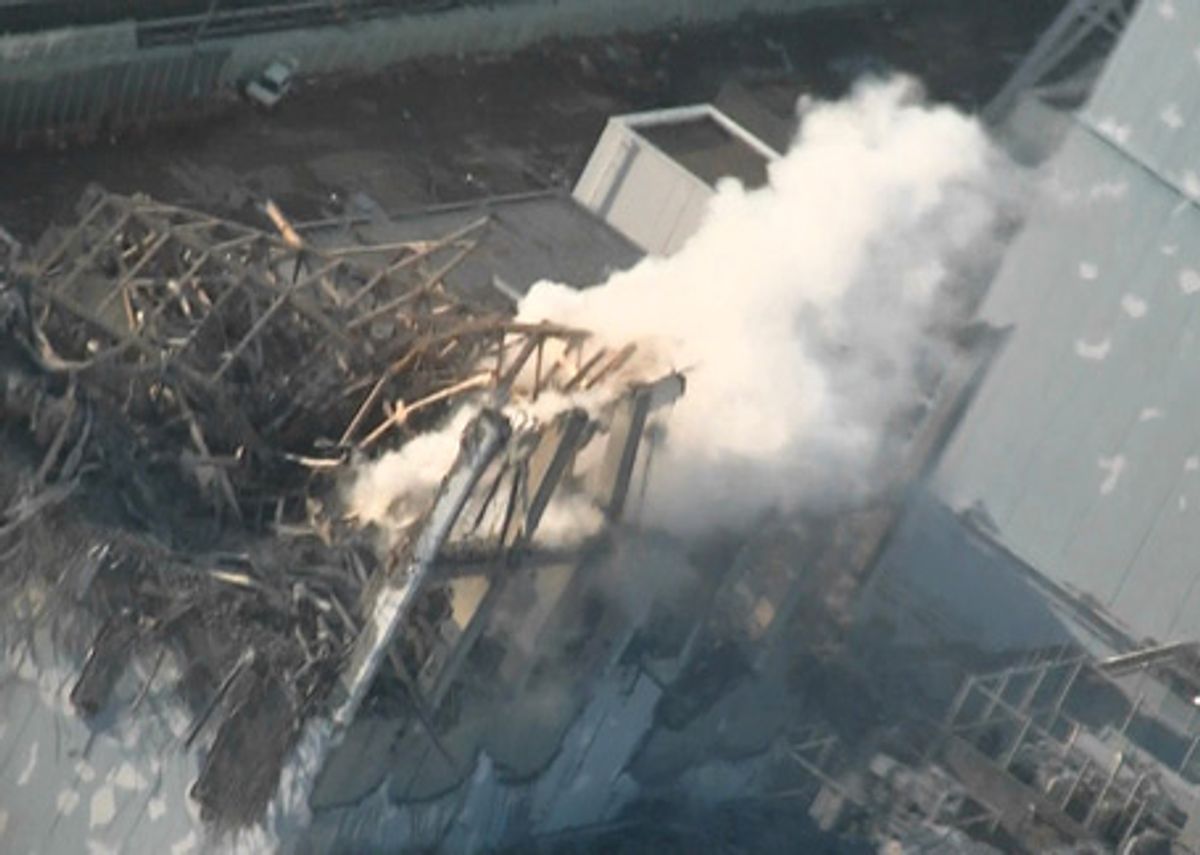Editor's Note: John Boyd is an IEEE Spectrum contributor reporting from Kawasaki, Japan. This is part of IEEE Spectrum's ongoing coverage of Japan's earthquake and nuclear emergency. For more details on how Fukushima Dai-1's nuclear reactors work and what has gone wrong so far, see our explainer.
Helicopters and water cannons: those are the latest tools employed in the desperate attempt to stabilize Japan's damaged power plant on day seven of the nuclear emergency.
On Thursday morning, steam flowed from the spent fuel storage pool in the No. 3 reactor building of the Fukushima Dai-1 nuclear power plant, and international authorities argued over the severity of the situation in the No. 4 reactor's storage pool.
Japan's Ministry of Defense, after talking with Prime Minister Naoto Kan and the government task force set up to deal with the nuclear crisis, sent two CH-47 Chinook helicopters (capable of carrying 7000 kilos of water) to drop seawater over the stricken No. 3 reactor building. The helicopter floors were fitted with lead plates to protect the crews, who also wore protective clothing.
The No. 3 reactor building was damaged by a hydrogen explosion on Monday morning. The openings made by the explosions should have enabled at least some water to enter the buildings from above. The water was intended to help cool down the overheating spent fuel rods: The still-radioactive rods continue to generate heat long after they're taken out of operation, so they're constantly cooled by water circulating through the storage pools. Although it's not clear exactly what went wrong, it appears that the storage pool in the No. 3 building has heated up and some of the water may have evaporated, which could have exposed the spent fuel rods to the air. If the rods have been exposed their nuclear fuel will heat up further and could begin to melt, increasing the likelihood of dangerous radiation.
(Yesterday afternoon it seemed that reactor building No. 4 would become the plant's top priority following alarming congressional testimony from Gregory Jaczko, chairman of the U.S. Nuclear Regulatory Commission. Jaczko stunned listeners by declaring that there was little or no water remaining in the storage pool in building No. 4 reactor, leaving the spent fuel rods exposed and leaking radiation. But the plant's owner, Tokyo Electric Power Company (TEPCO), has rebutted Jaczko's claims, and a Self-Defense Force pilot flying over the site on Thursday reported seeing water in the spent fuel storage pool of reactor building 4.)
Despite the real danger posed by the spent fuel rods and the radiation they're emitting, one expert told Spectrum there was no chance of recriticality, the re-ignition of a self-sustaining nuclear reaction, occurring. "The fissionable material remaining inside the spent fuel pellets is maybe about 1 percent," said Kazuaki Matsui, executive managing director of the Institute of Applied Energy, an independent organization in Tokyo. "Fissionable material contains maybe 3 or 4 percent of uranium-235. But we're talking here about spent fuel, otherwise it wouldn't have been removed."
NHK, Japan's national broadcaster, positioned a TV camera 33 kilometers southwest of the plant, and broadcast the helicopter operation live. At 9:48 a.m. local time a helicopter flying from the west dropped the first load of water almost directly over the No. 3 reactor, though a significant amount spread away from before reaching the target. A second helicopter flying from the east then dumped its water over reactors No. 4 and No. 3. Two more passes were made before the operation was suspended around 10 a.m.
No steam was seen escaping from building No. 3 immediately after the last helicopter pass, but later views showed small amounts of steam being released. NHK reported a TEPCO official saying that there had been little change in the radiation level measured after the operation ended.
Minister of Defense Toshimi Kitazawa told reporters at a press conference following the aerial drop that operations had been suspended for the time being, but "more aerial drops will be conducted as necessary." He said an inspection was taking place to determine how effective the aerial drop had been.
Kitazawa also announced that the National Police Agency had special water cannon trucks and crews ready to move in to begin spraying water directly into the reactors once plant operators deemed it was safe to approach the plant. The crews would wear protective clothing provided by the Self-Defense Force. The water cannons are typically used to control riots, and can reportedly hit a target with a powerful stream of water from a distance of 100 meters. That operation began on Thursday afternoon (local time), but according to NHK the water failed to reach its target. The operation was soon suspended due to high radiation levels.
The next assault involved what Kitazawa described as "eleven special water-spraying trucks," which he said came from various military bases around Japan. The Self-Defense Force put these trucks into action on Thursday evening (local time), and sprayed a total of 30 tons of water over reactor building No. 3 over the course of 30 minutes. Officials told NHK that the water did reach the building's interior, but they couldn't immediately say whether it had reached the spent fuel storage pool.
In a separate press conference, an official from Japan's Nuclear and Industrial Safety Agency said that workers were trying to reconnect the Fukushima Dai-1 plant to outside power lines on Thursday. Power was cut off when the earthquake struck last Friday afternoon, so the plant's operators have been running the emergency cooling systems on generators and batteries.
Image: DigitalGlobe / Getty Images





